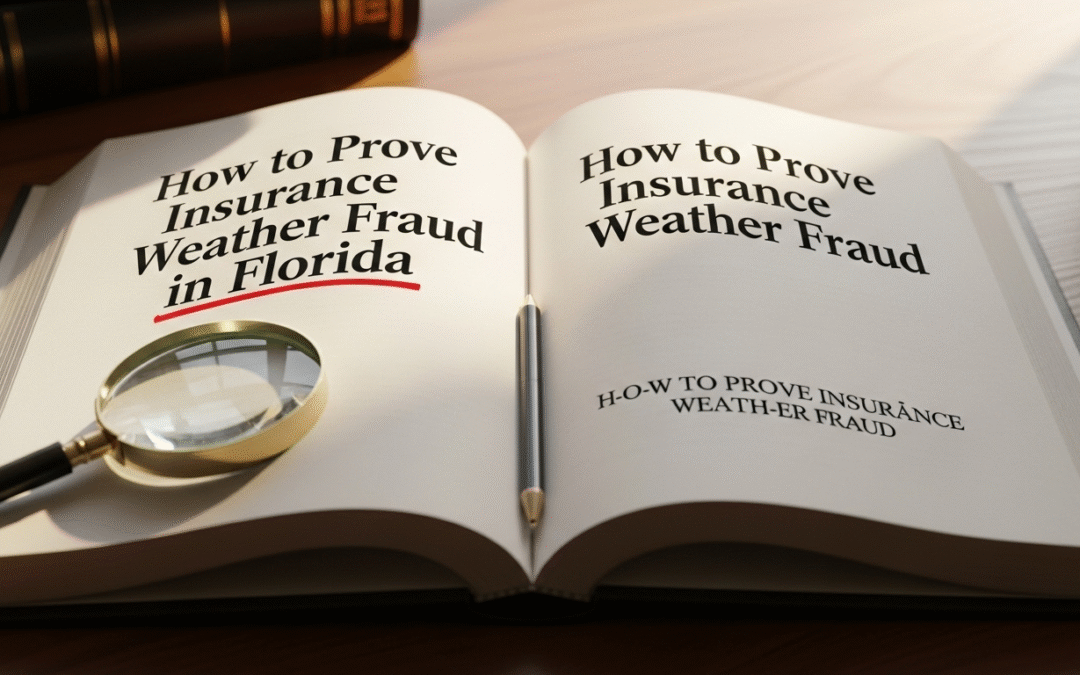How Florida Insurance Companies Are Combating Weather Claim Fraud With Forensic Meteorologists
Introduction
Florida’s tropical climate, with its hurricanes, severe thunderstorms, hail, and flooding, leads to thousands of weather-related insurance claims each year. While most claims are legitimate, a significant number are exaggerated or entirely fraudulent. This type of fraud inflates insurers’ costs and raises premiums for honest policyholders. Insurance companies have recently turned to advanced meteorological tools, forensic weather analysis, and data integration to verify claims and protect against weather-related fraud.
TL;DR: Florida insurers are cracking down on weather-related claim fraud using forensic meteorology, official NOAA/NWS data, radar and satellite archives, lightning detection networks, and on-the-ground inspections. These tools confirm whether damaging weather occurred at a specific time and location, detect inconsistencies, and block payouts for false or inflated claims—keeping costs down and premiums fair for honest policyholders.
Understanding Weather-Related Claim Fraud
Weather-related insurance fraud occurs when claimants exaggerate the extent of damage, falsify the date or cause of the damage, or file claims for damage that never occurred.
- Roofing fraud after hurricanes or hailstorms.
- Flood damage exaggerations after tropical systems.
- Wind damage misrepresentation following severe thunderstorms.
- Hail damage claims are tied to unrelated or older events.
Tools and Technologies Used to Detect Fraud
1. Forensic Meteorology Reports
Insurance companies now partner with forensic meteorologists who analyze historical weather data, radar imagery, lightning detection networks, and official NOAA and the National Weather Service (NWS) storm reports. These reports verify whether damaging weather occurred at a specific location and time. Data sources include NCEI storm event databases, NWS Local Storm Reports, and ASOS/AWOS station records.
2. Radar and Satellite Data Correlation
High-resolution Doppler radar archives allow insurers to confirm the presence of hail cores, wind shear signatures, or rainfall totals on the date of loss. Satellite imagery helps confirm the area’s cloud patterns and storm systems at the claimed time.
3. Lightning Detection Networks
Lightning data from systems like Vaisala’s NLDN or Earth Networks Total Lightning Network is used to confirm cloud-to-ground strikes. If a claim references a lightning strike as the cause of damage, the exact time and GPS coordinates of strikes can be cross-checked against the property location.
4. On-the-Ground Damage Assessment
Insurers use engineering inspections, roof core sampling, and material analysis to determine if damage is consistent with the claimed weather event. Drone technology allows detailed aerial surveys after storms, helping identify patterns inconsistent with the reported event.
5. Historical Weather Pattern Analysis
By reviewing long-term climatology for a region, insurers can flag suspicious claims made during unusually calm periods. This prevents payouts for supposed “storm damage” when weather records show no severe weather for weeks or months.
Strategies for Fraud Prevention
- Mandatory Weather Verification Before Payment – Claims are automatically cross-checked with meteorological data before approval.
- Collaboration with State and Federal Agencies – Insurers work closely with the Florida Division of Insurance Fraud and NOAA to ensure claims are backed by official data.
- Rapid-Response Teams—After a Storm, insurers deploy assessment teams quickly to document actual damage before repairs or fraudulent alterations can occur.
- Public Awareness Campaigns – Educating policyholders about fraud consequences and the verification process helps deter fraudulent activity.
Case Studies in Florida
Hurricane Michael Roofing Claims
After Hurricane Michael in 2018, some contractors encouraged homeowners to file roof replacement claims despite minimal damage. Insurers compared claims to forensic weather reports showing wind gusts in the area were below roof damage thresholds. Many fraudulent claims were denied, saving millions.
Lightning Strike Verifications in Orlando
A series of claims for damaged HVAC units due to lightning were cross-checked with lightning strike logs. In multiple cases, there were no strikes within five miles of the properties on the claimed date. These claims were rejected based on forensic lightning analysis.
Hail Claims in Central Florida
Following a small hailstorm, dozens of homeowners submitted claims for major roof replacements. Radar-based hail swath maps showed only pea-sized hail in most of the area, insufficient to cause significant shingle damage. These claims were denied after engineering inspections confirmed the weather data.
Future of Weather Fraud Prevention
Weather claim fraud prevention will only become more advanced. In the coming years, expect to see:
- Real-Time Weather Verification APIs are integrated directly into claims software.
- More Detailed Storm Impact Models that match specific damage signatures to wind speed, hail size, or rainfall totals.
- Increased Drone and Satellite Use for near-instant post-storm property assessments.
Conclusion
Weather claim fraud is a costly problem in Florida’s storm-prone environment. By leveraging forensic meteorology, historical weather records, and modern damage assessment technologies, insurance companies are becoming far more effective at detecting and preventing fraudulent claims. These efforts not only protect insurers but also help keep premiums fair for honest policyholders—ensuring the system works as intended when genuine weather disasters strike.
Use the contact form below or email me for a free case review.
Contact – Scroll Down – John Bryant
901.283.3099
Want to know more about forensic meteorology? I have listed some great resources below.
National Oceanic and Atmospheric Administration (NOAA)
National Centers for Environmental Information
American Meteorological Society
SEAK Experts – Forensic Meteorology
Penn State Department of Meteorology and Atmospheric Science
University of Oklahoma School of Meteorology
Colorado State University Atmospheric Science
University of Washington Atmospheric Sciences
MIT Earth, Atmospheric and Planetary Sciences
The author of this article is not an attorney. The article is meant to be a resource for meteorology. Contacting a qualified lawyer for legal matters is recommended if you need legal advice.

